Chapter 3: Research Methodology for Oil & Gas Industry Study
VerifiedAdded on 2019/12/18
|9
|2919
|1371
Report
AI Summary
This chapter meticulously outlines the research methodology employed in a study focusing on the impact of balanced scorecards and KPIs on management decision-making within the oil and gas industry. It begins by justifying the selection of a post-positivism research philosophy, acknowledging the potential for errors in data collection and the need for revision. The report details the use of a descriptive research design and an inductive research approach. The chapter then explains the data collection methods, which include both primary and secondary sources, with a focus on quantitative data derived from a large employee sample and qualitative data from managerial feedback. The instrumentation section covers the use of surveys, questionnaires, checklists, and flowcharts. The data analysis section highlights the use of both qualitative and quantitative methods, including statistical and mathematical tools, alongside graphical representations. The chapter emphasizes the importance of scale reliability and adherence to academic guidelines, ensuring the validity and reliability of the collected data, and the final section summarizes the approach and methods used throughout the research.
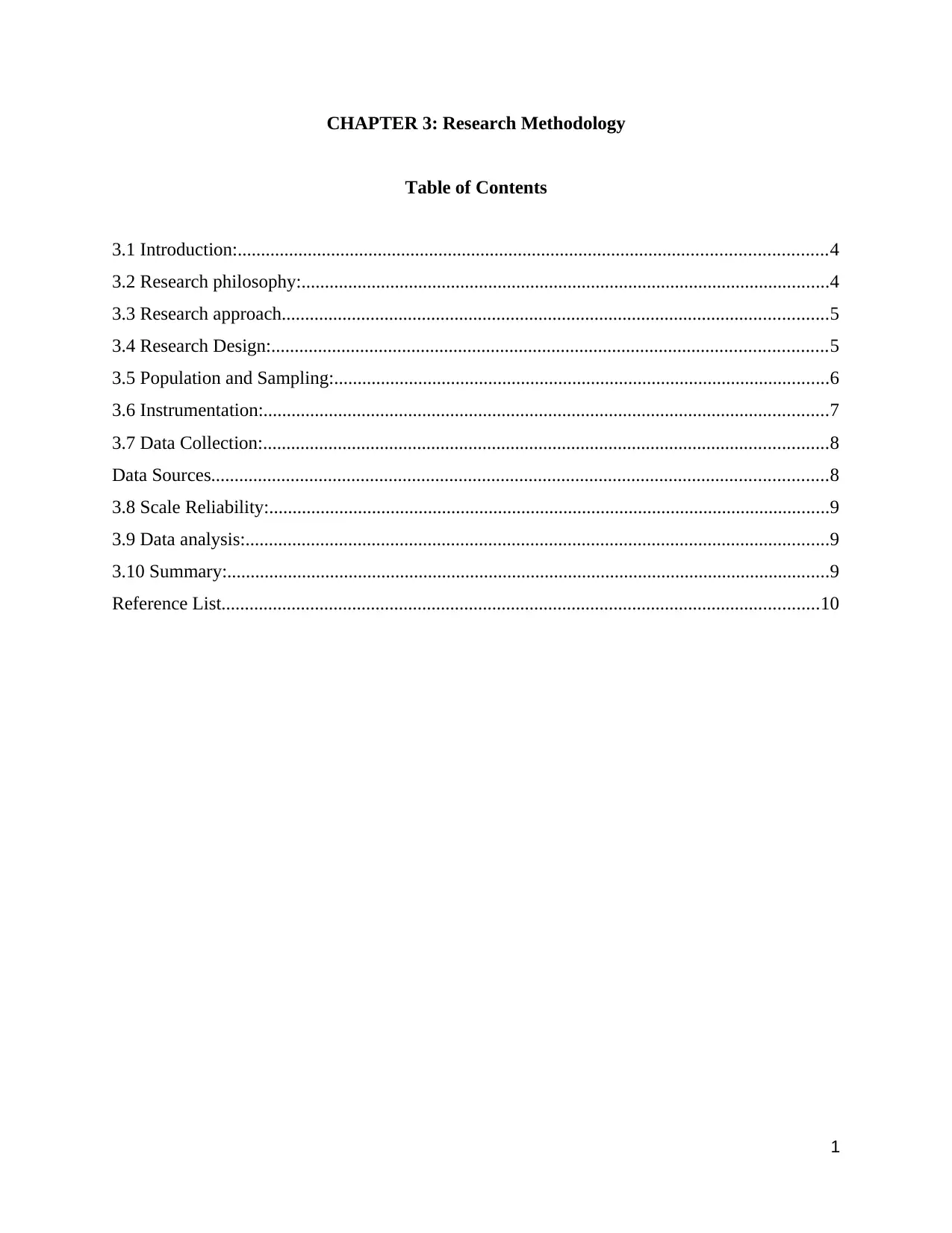
CHAPTER 3: Research Methodology
Table of Contents
3.1 Introduction:..............................................................................................................................4
3.2 Research philosophy:.................................................................................................................4
3.3 Research approach.....................................................................................................................5
3.4 Research Design:.......................................................................................................................5
3.5 Population and Sampling:..........................................................................................................6
3.6 Instrumentation:.........................................................................................................................7
3.7 Data Collection:.........................................................................................................................8
Data Sources....................................................................................................................................8
3.8 Scale Reliability:........................................................................................................................9
3.9 Data analysis:.............................................................................................................................9
3.10 Summary:.................................................................................................................................9
Reference List................................................................................................................................10
1
Table of Contents
3.1 Introduction:..............................................................................................................................4
3.2 Research philosophy:.................................................................................................................4
3.3 Research approach.....................................................................................................................5
3.4 Research Design:.......................................................................................................................5
3.5 Population and Sampling:..........................................................................................................6
3.6 Instrumentation:.........................................................................................................................7
3.7 Data Collection:.........................................................................................................................8
Data Sources....................................................................................................................................8
3.8 Scale Reliability:........................................................................................................................9
3.9 Data analysis:.............................................................................................................................9
3.10 Summary:.................................................................................................................................9
Reference List................................................................................................................................10
1
Paraphrase This Document
Need a fresh take? Get an instant paraphrase of this document with our AI Paraphraser
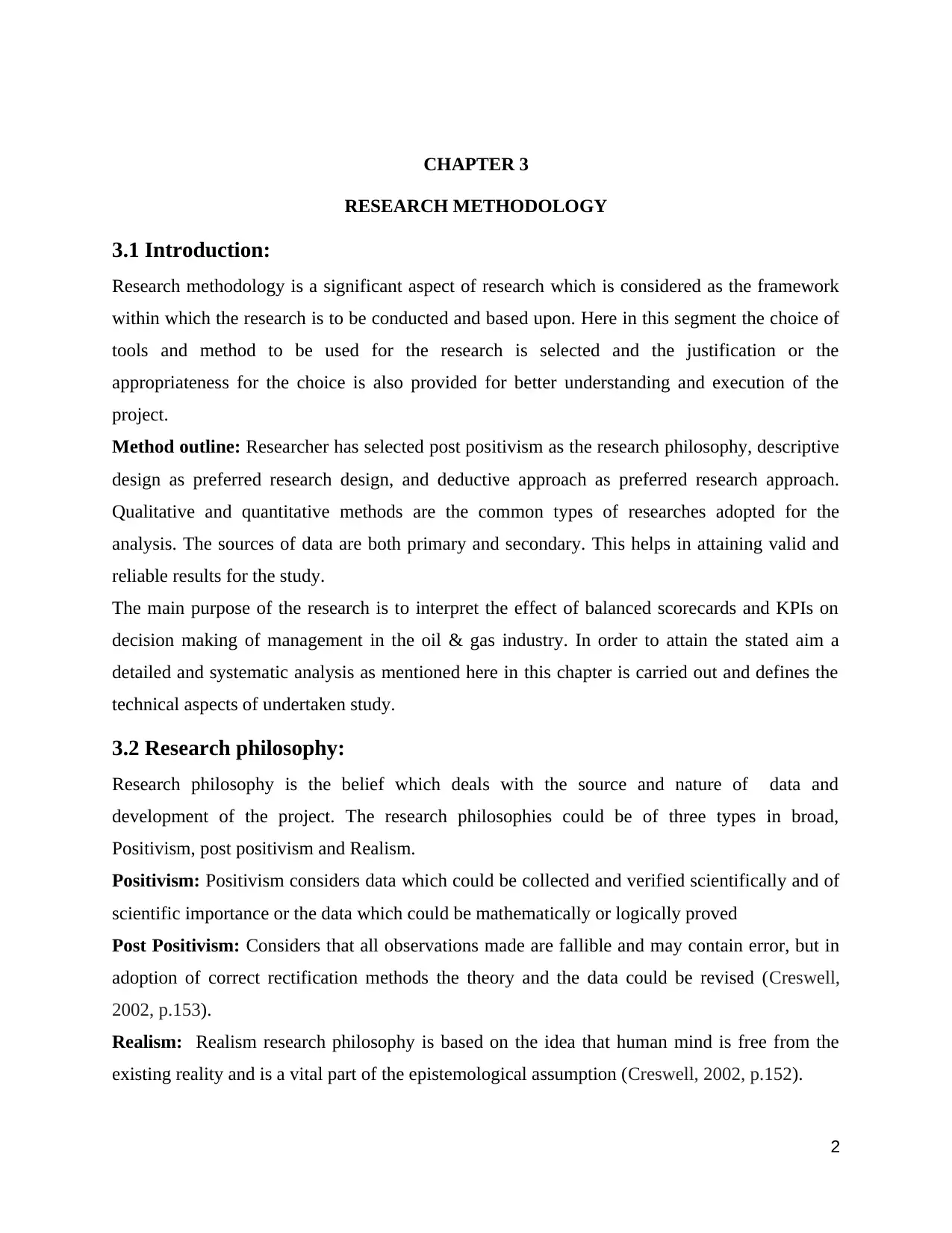
CHAPTER 3
RESEARCH METHODOLOGY
3.1 Introduction:
Research methodology is a significant aspect of research which is considered as the framework
within which the research is to be conducted and based upon. Here in this segment the choice of
tools and method to be used for the research is selected and the justification or the
appropriateness for the choice is also provided for better understanding and execution of the
project.
Method outline: Researcher has selected post positivism as the research philosophy, descriptive
design as preferred research design, and deductive approach as preferred research approach.
Qualitative and quantitative methods are the common types of researches adopted for the
analysis. The sources of data are both primary and secondary. This helps in attaining valid and
reliable results for the study.
The main purpose of the research is to interpret the effect of balanced scorecards and KPIs on
decision making of management in the oil & gas industry. In order to attain the stated aim a
detailed and systematic analysis as mentioned here in this chapter is carried out and defines the
technical aspects of undertaken study.
3.2 Research philosophy:
Research philosophy is the belief which deals with the source and nature of data and
development of the project. The research philosophies could be of three types in broad,
Positivism, post positivism and Realism.
Positivism: Positivism considers data which could be collected and verified scientifically and of
scientific importance or the data which could be mathematically or logically proved
Post Positivism: Considers that all observations made are fallible and may contain error, but in
adoption of correct rectification methods the theory and the data could be revised (Creswell,
2002, p.153).
Realism: Realism research philosophy is based on the idea that human mind is free from the
existing reality and is a vital part of the epistemological assumption (Creswell, 2002, p.152).
2
RESEARCH METHODOLOGY
3.1 Introduction:
Research methodology is a significant aspect of research which is considered as the framework
within which the research is to be conducted and based upon. Here in this segment the choice of
tools and method to be used for the research is selected and the justification or the
appropriateness for the choice is also provided for better understanding and execution of the
project.
Method outline: Researcher has selected post positivism as the research philosophy, descriptive
design as preferred research design, and deductive approach as preferred research approach.
Qualitative and quantitative methods are the common types of researches adopted for the
analysis. The sources of data are both primary and secondary. This helps in attaining valid and
reliable results for the study.
The main purpose of the research is to interpret the effect of balanced scorecards and KPIs on
decision making of management in the oil & gas industry. In order to attain the stated aim a
detailed and systematic analysis as mentioned here in this chapter is carried out and defines the
technical aspects of undertaken study.
3.2 Research philosophy:
Research philosophy is the belief which deals with the source and nature of data and
development of the project. The research philosophies could be of three types in broad,
Positivism, post positivism and Realism.
Positivism: Positivism considers data which could be collected and verified scientifically and of
scientific importance or the data which could be mathematically or logically proved
Post Positivism: Considers that all observations made are fallible and may contain error, but in
adoption of correct rectification methods the theory and the data could be revised (Creswell,
2002, p.153).
Realism: Realism research philosophy is based on the idea that human mind is free from the
existing reality and is a vital part of the epistemological assumption (Creswell, 2002, p.152).
2
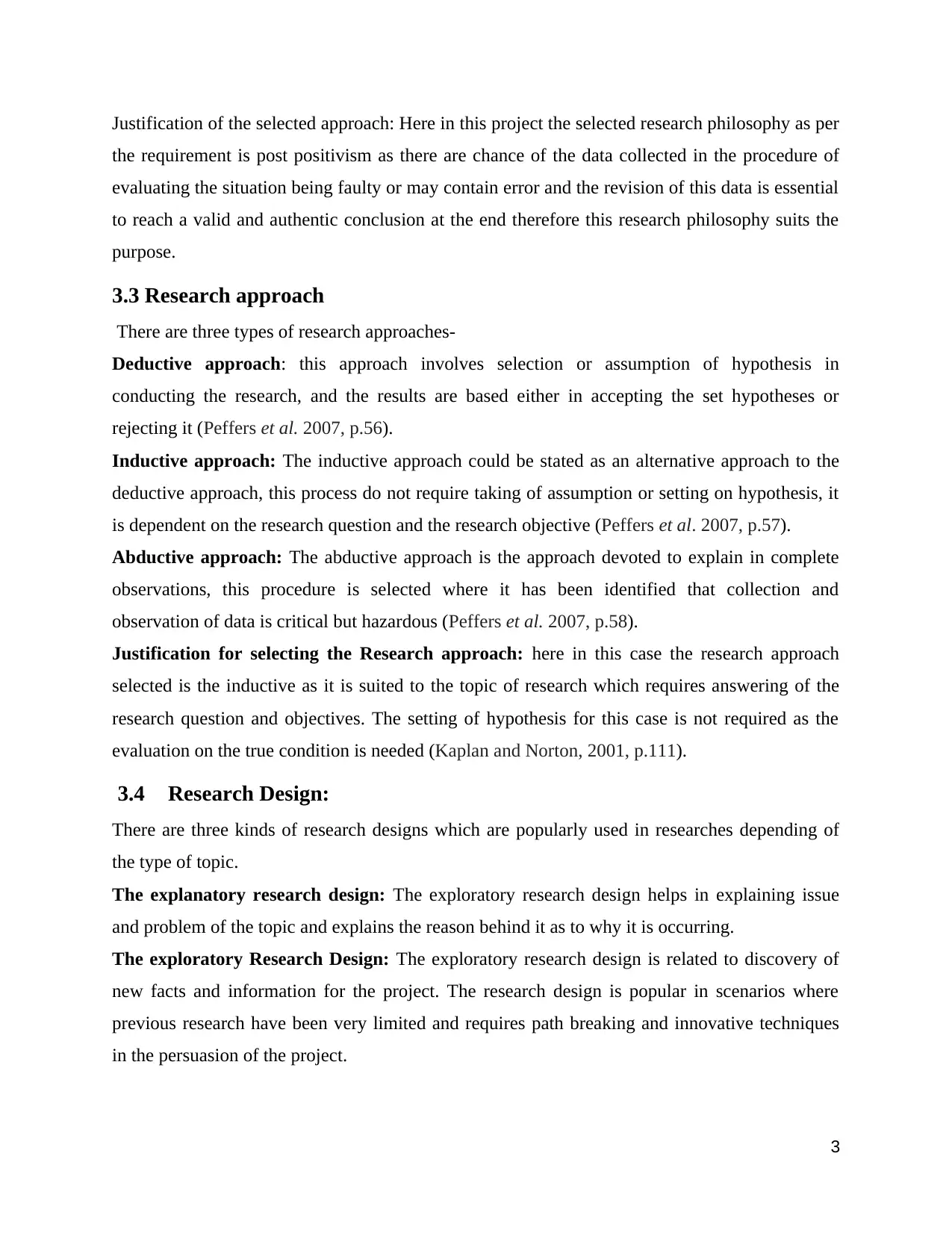
Justification of the selected approach: Here in this project the selected research philosophy as per
the requirement is post positivism as there are chance of the data collected in the procedure of
evaluating the situation being faulty or may contain error and the revision of this data is essential
to reach a valid and authentic conclusion at the end therefore this research philosophy suits the
purpose.
3.3 Research approach
There are three types of research approaches-
Deductive approach: this approach involves selection or assumption of hypothesis in
conducting the research, and the results are based either in accepting the set hypotheses or
rejecting it (Peffers et al. 2007, p.56).
Inductive approach: The inductive approach could be stated as an alternative approach to the
deductive approach, this process do not require taking of assumption or setting on hypothesis, it
is dependent on the research question and the research objective (Peffers et al. 2007, p.57).
Abductive approach: The abductive approach is the approach devoted to explain in complete
observations, this procedure is selected where it has been identified that collection and
observation of data is critical but hazardous (Peffers et al. 2007, p.58).
Justification for selecting the Research approach: here in this case the research approach
selected is the inductive as it is suited to the topic of research which requires answering of the
research question and objectives. The setting of hypothesis for this case is not required as the
evaluation on the true condition is needed (Kaplan and Norton, 2001, p.111).
3.4 Research Design:
There are three kinds of research designs which are popularly used in researches depending of
the type of topic.
The explanatory research design: The exploratory research design helps in explaining issue
and problem of the topic and explains the reason behind it as to why it is occurring.
The exploratory Research Design: The exploratory research design is related to discovery of
new facts and information for the project. The research design is popular in scenarios where
previous research have been very limited and requires path breaking and innovative techniques
in the persuasion of the project.
3
the requirement is post positivism as there are chance of the data collected in the procedure of
evaluating the situation being faulty or may contain error and the revision of this data is essential
to reach a valid and authentic conclusion at the end therefore this research philosophy suits the
purpose.
3.3 Research approach
There are three types of research approaches-
Deductive approach: this approach involves selection or assumption of hypothesis in
conducting the research, and the results are based either in accepting the set hypotheses or
rejecting it (Peffers et al. 2007, p.56).
Inductive approach: The inductive approach could be stated as an alternative approach to the
deductive approach, this process do not require taking of assumption or setting on hypothesis, it
is dependent on the research question and the research objective (Peffers et al. 2007, p.57).
Abductive approach: The abductive approach is the approach devoted to explain in complete
observations, this procedure is selected where it has been identified that collection and
observation of data is critical but hazardous (Peffers et al. 2007, p.58).
Justification for selecting the Research approach: here in this case the research approach
selected is the inductive as it is suited to the topic of research which requires answering of the
research question and objectives. The setting of hypothesis for this case is not required as the
evaluation on the true condition is needed (Kaplan and Norton, 2001, p.111).
3.4 Research Design:
There are three kinds of research designs which are popularly used in researches depending of
the type of topic.
The explanatory research design: The exploratory research design helps in explaining issue
and problem of the topic and explains the reason behind it as to why it is occurring.
The exploratory Research Design: The exploratory research design is related to discovery of
new facts and information for the project. The research design is popular in scenarios where
previous research have been very limited and requires path breaking and innovative techniques
in the persuasion of the project.
3
⊘ This is a preview!⊘
Do you want full access?
Subscribe today to unlock all pages.

Trusted by 1+ million students worldwide
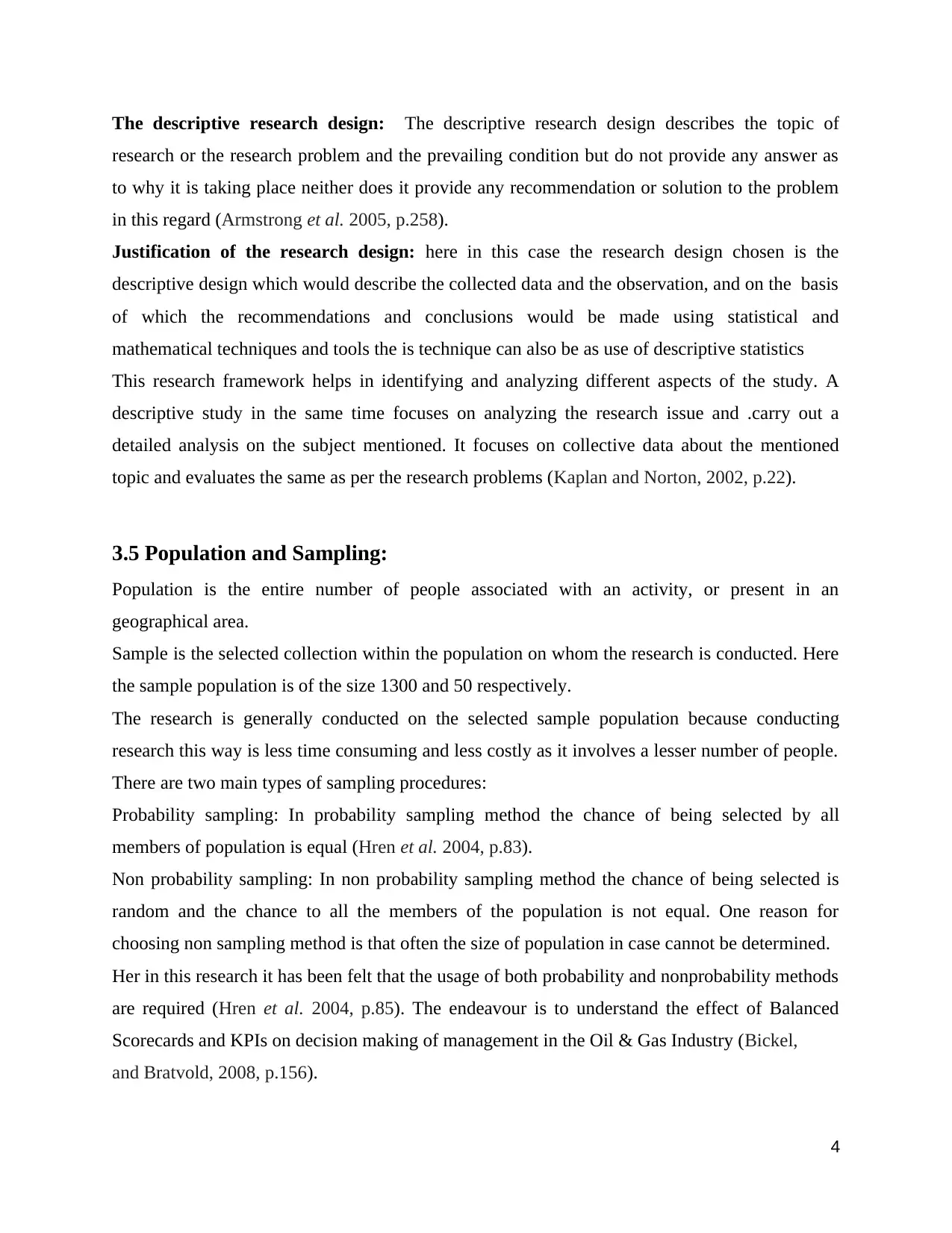
The descriptive research design: The descriptive research design describes the topic of
research or the research problem and the prevailing condition but do not provide any answer as
to why it is taking place neither does it provide any recommendation or solution to the problem
in this regard (Armstrong et al. 2005, p.258).
Justification of the research design: here in this case the research design chosen is the
descriptive design which would describe the collected data and the observation, and on the basis
of which the recommendations and conclusions would be made using statistical and
mathematical techniques and tools the is technique can also be as use of descriptive statistics
This research framework helps in identifying and analyzing different aspects of the study. A
descriptive study in the same time focuses on analyzing the research issue and .carry out a
detailed analysis on the subject mentioned. It focuses on collective data about the mentioned
topic and evaluates the same as per the research problems (Kaplan and Norton, 2002, p.22).
3.5 Population and Sampling:
Population is the entire number of people associated with an activity, or present in an
geographical area.
Sample is the selected collection within the population on whom the research is conducted. Here
the sample population is of the size 1300 and 50 respectively.
The research is generally conducted on the selected sample population because conducting
research this way is less time consuming and less costly as it involves a lesser number of people.
There are two main types of sampling procedures:
Probability sampling: In probability sampling method the chance of being selected by all
members of population is equal (Hren et al. 2004, p.83).
Non probability sampling: In non probability sampling method the chance of being selected is
random and the chance to all the members of the population is not equal. One reason for
choosing non sampling method is that often the size of population in case cannot be determined.
Her in this research it has been felt that the usage of both probability and nonprobability methods
are required (Hren et al. 2004, p.85). The endeavour is to understand the effect of Balanced
Scorecards and KPIs on decision making of management in the Oil & Gas Industry (Bickel,
and Bratvold, 2008, p.156).
4
research or the research problem and the prevailing condition but do not provide any answer as
to why it is taking place neither does it provide any recommendation or solution to the problem
in this regard (Armstrong et al. 2005, p.258).
Justification of the research design: here in this case the research design chosen is the
descriptive design which would describe the collected data and the observation, and on the basis
of which the recommendations and conclusions would be made using statistical and
mathematical techniques and tools the is technique can also be as use of descriptive statistics
This research framework helps in identifying and analyzing different aspects of the study. A
descriptive study in the same time focuses on analyzing the research issue and .carry out a
detailed analysis on the subject mentioned. It focuses on collective data about the mentioned
topic and evaluates the same as per the research problems (Kaplan and Norton, 2002, p.22).
3.5 Population and Sampling:
Population is the entire number of people associated with an activity, or present in an
geographical area.
Sample is the selected collection within the population on whom the research is conducted. Here
the sample population is of the size 1300 and 50 respectively.
The research is generally conducted on the selected sample population because conducting
research this way is less time consuming and less costly as it involves a lesser number of people.
There are two main types of sampling procedures:
Probability sampling: In probability sampling method the chance of being selected by all
members of population is equal (Hren et al. 2004, p.83).
Non probability sampling: In non probability sampling method the chance of being selected is
random and the chance to all the members of the population is not equal. One reason for
choosing non sampling method is that often the size of population in case cannot be determined.
Her in this research it has been felt that the usage of both probability and nonprobability methods
are required (Hren et al. 2004, p.85). The endeavour is to understand the effect of Balanced
Scorecards and KPIs on decision making of management in the Oil & Gas Industry (Bickel,
and Bratvold, 2008, p.156).
4
Paraphrase This Document
Need a fresh take? Get an instant paraphrase of this document with our AI Paraphraser
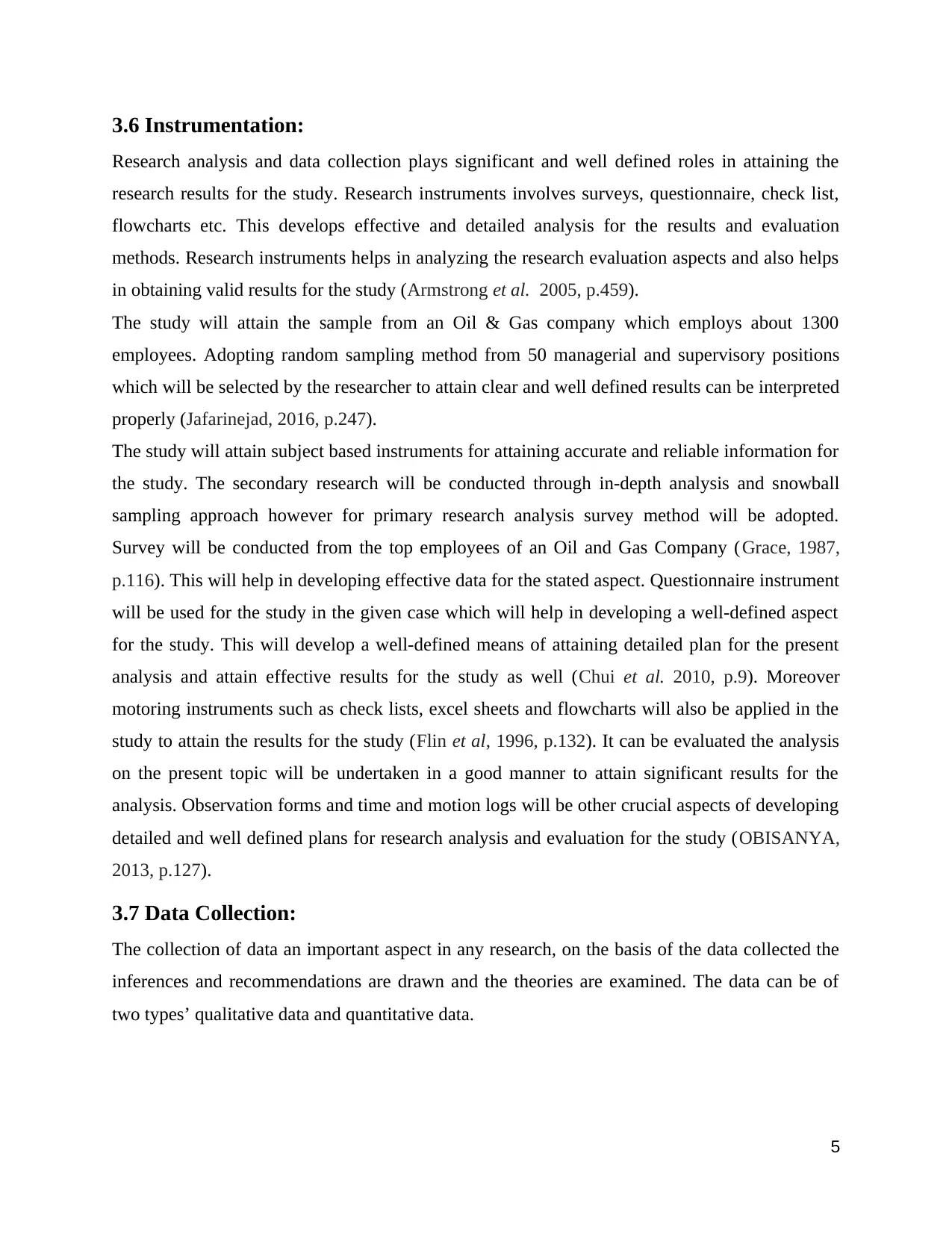
3.6 Instrumentation:
Research analysis and data collection plays significant and well defined roles in attaining the
research results for the study. Research instruments involves surveys, questionnaire, check list,
flowcharts etc. This develops effective and detailed analysis for the results and evaluation
methods. Research instruments helps in analyzing the research evaluation aspects and also helps
in obtaining valid results for the study (Armstrong et al. 2005, p.459).
The study will attain the sample from an Oil & Gas company which employs about 1300
employees. Adopting random sampling method from 50 managerial and supervisory positions
which will be selected by the researcher to attain clear and well defined results can be interpreted
properly (Jafarinejad, 2016, p.247).
The study will attain subject based instruments for attaining accurate and reliable information for
the study. The secondary research will be conducted through in-depth analysis and snowball
sampling approach however for primary research analysis survey method will be adopted.
Survey will be conducted from the top employees of an Oil and Gas Company (Grace, 1987,
p.116). This will help in developing effective data for the stated aspect. Questionnaire instrument
will be used for the study in the given case which will help in developing a well-defined aspect
for the study. This will develop a well-defined means of attaining detailed plan for the present
analysis and attain effective results for the study as well (Chui et al. 2010, p.9). Moreover
motoring instruments such as check lists, excel sheets and flowcharts will also be applied in the
study to attain the results for the study (Flin et al, 1996, p.132). It can be evaluated the analysis
on the present topic will be undertaken in a good manner to attain significant results for the
analysis. Observation forms and time and motion logs will be other crucial aspects of developing
detailed and well defined plans for research analysis and evaluation for the study (OBISANYA,
2013, p.127).
3.7 Data Collection:
The collection of data an important aspect in any research, on the basis of the data collected the
inferences and recommendations are drawn and the theories are examined. The data can be of
two types’ qualitative data and quantitative data.
5
Research analysis and data collection plays significant and well defined roles in attaining the
research results for the study. Research instruments involves surveys, questionnaire, check list,
flowcharts etc. This develops effective and detailed analysis for the results and evaluation
methods. Research instruments helps in analyzing the research evaluation aspects and also helps
in obtaining valid results for the study (Armstrong et al. 2005, p.459).
The study will attain the sample from an Oil & Gas company which employs about 1300
employees. Adopting random sampling method from 50 managerial and supervisory positions
which will be selected by the researcher to attain clear and well defined results can be interpreted
properly (Jafarinejad, 2016, p.247).
The study will attain subject based instruments for attaining accurate and reliable information for
the study. The secondary research will be conducted through in-depth analysis and snowball
sampling approach however for primary research analysis survey method will be adopted.
Survey will be conducted from the top employees of an Oil and Gas Company (Grace, 1987,
p.116). This will help in developing effective data for the stated aspect. Questionnaire instrument
will be used for the study in the given case which will help in developing a well-defined aspect
for the study. This will develop a well-defined means of attaining detailed plan for the present
analysis and attain effective results for the study as well (Chui et al. 2010, p.9). Moreover
motoring instruments such as check lists, excel sheets and flowcharts will also be applied in the
study to attain the results for the study (Flin et al, 1996, p.132). It can be evaluated the analysis
on the present topic will be undertaken in a good manner to attain significant results for the
analysis. Observation forms and time and motion logs will be other crucial aspects of developing
detailed and well defined plans for research analysis and evaluation for the study (OBISANYA,
2013, p.127).
3.7 Data Collection:
The collection of data an important aspect in any research, on the basis of the data collected the
inferences and recommendations are drawn and the theories are examined. The data can be of
two types’ qualitative data and quantitative data.
5
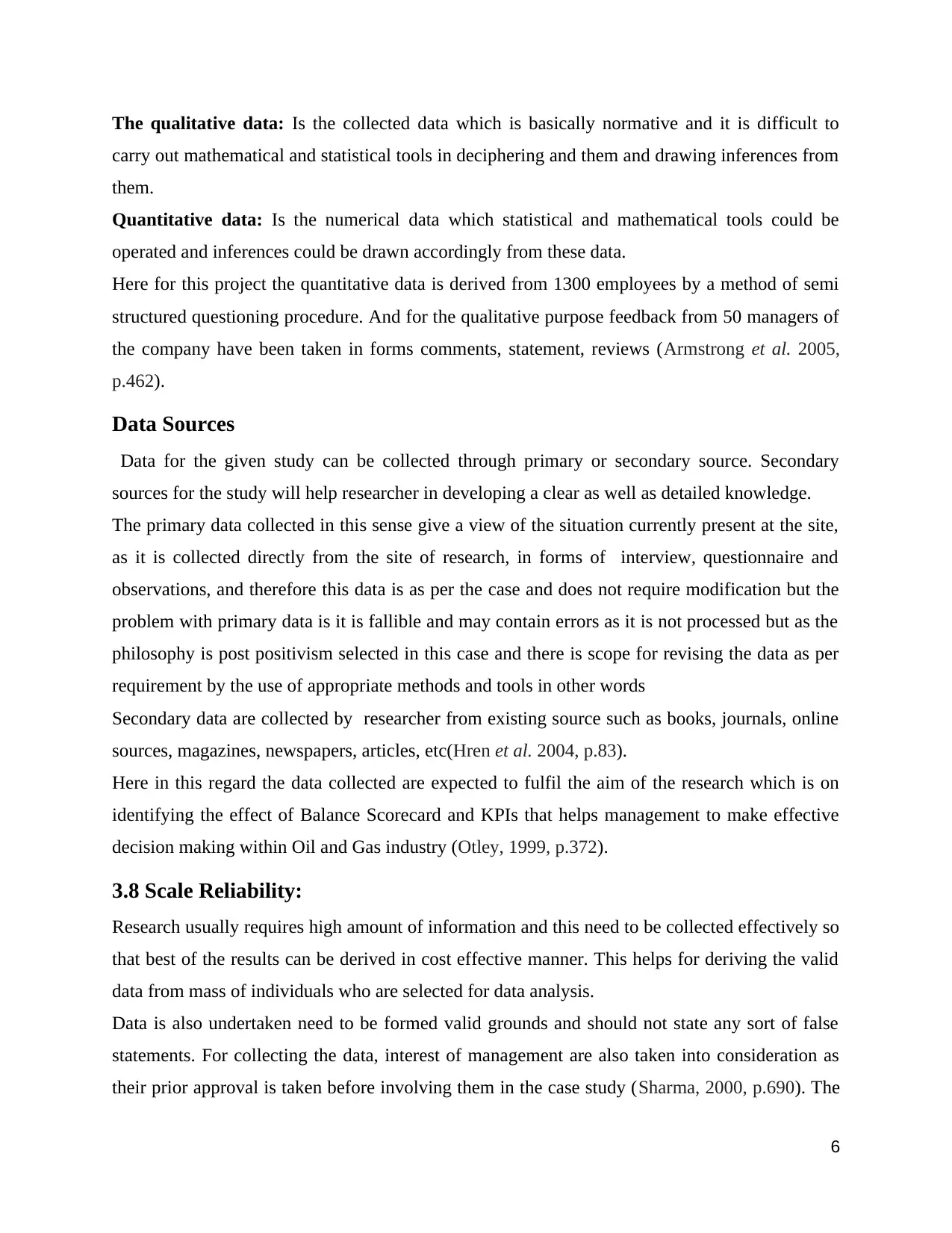
The qualitative data: Is the collected data which is basically normative and it is difficult to
carry out mathematical and statistical tools in deciphering and them and drawing inferences from
them.
Quantitative data: Is the numerical data which statistical and mathematical tools could be
operated and inferences could be drawn accordingly from these data.
Here for this project the quantitative data is derived from 1300 employees by a method of semi
structured questioning procedure. And for the qualitative purpose feedback from 50 managers of
the company have been taken in forms comments, statement, reviews (Armstrong et al. 2005,
p.462).
Data Sources
Data for the given study can be collected through primary or secondary source. Secondary
sources for the study will help researcher in developing a clear as well as detailed knowledge.
The primary data collected in this sense give a view of the situation currently present at the site,
as it is collected directly from the site of research, in forms of interview, questionnaire and
observations, and therefore this data is as per the case and does not require modification but the
problem with primary data is it is fallible and may contain errors as it is not processed but as the
philosophy is post positivism selected in this case and there is scope for revising the data as per
requirement by the use of appropriate methods and tools in other words
Secondary data are collected by researcher from existing source such as books, journals, online
sources, magazines, newspapers, articles, etc(Hren et al. 2004, p.83).
Here in this regard the data collected are expected to fulfil the aim of the research which is on
identifying the effect of Balance Scorecard and KPIs that helps management to make effective
decision making within Oil and Gas industry (Otley, 1999, p.372).
3.8 Scale Reliability:
Research usually requires high amount of information and this need to be collected effectively so
that best of the results can be derived in cost effective manner. This helps for deriving the valid
data from mass of individuals who are selected for data analysis.
Data is also undertaken need to be formed valid grounds and should not state any sort of false
statements. For collecting the data, interest of management are also taken into consideration as
their prior approval is taken before involving them in the case study (Sharma, 2000, p.690). The
6
carry out mathematical and statistical tools in deciphering and them and drawing inferences from
them.
Quantitative data: Is the numerical data which statistical and mathematical tools could be
operated and inferences could be drawn accordingly from these data.
Here for this project the quantitative data is derived from 1300 employees by a method of semi
structured questioning procedure. And for the qualitative purpose feedback from 50 managers of
the company have been taken in forms comments, statement, reviews (Armstrong et al. 2005,
p.462).
Data Sources
Data for the given study can be collected through primary or secondary source. Secondary
sources for the study will help researcher in developing a clear as well as detailed knowledge.
The primary data collected in this sense give a view of the situation currently present at the site,
as it is collected directly from the site of research, in forms of interview, questionnaire and
observations, and therefore this data is as per the case and does not require modification but the
problem with primary data is it is fallible and may contain errors as it is not processed but as the
philosophy is post positivism selected in this case and there is scope for revising the data as per
requirement by the use of appropriate methods and tools in other words
Secondary data are collected by researcher from existing source such as books, journals, online
sources, magazines, newspapers, articles, etc(Hren et al. 2004, p.83).
Here in this regard the data collected are expected to fulfil the aim of the research which is on
identifying the effect of Balance Scorecard and KPIs that helps management to make effective
decision making within Oil and Gas industry (Otley, 1999, p.372).
3.8 Scale Reliability:
Research usually requires high amount of information and this need to be collected effectively so
that best of the results can be derived in cost effective manner. This helps for deriving the valid
data from mass of individuals who are selected for data analysis.
Data is also undertaken need to be formed valid grounds and should not state any sort of false
statements. For collecting the data, interest of management are also taken into consideration as
their prior approval is taken before involving them in the case study (Sharma, 2000, p.690). The
6
⊘ This is a preview!⊘
Do you want full access?
Subscribe today to unlock all pages.

Trusted by 1+ million students worldwide
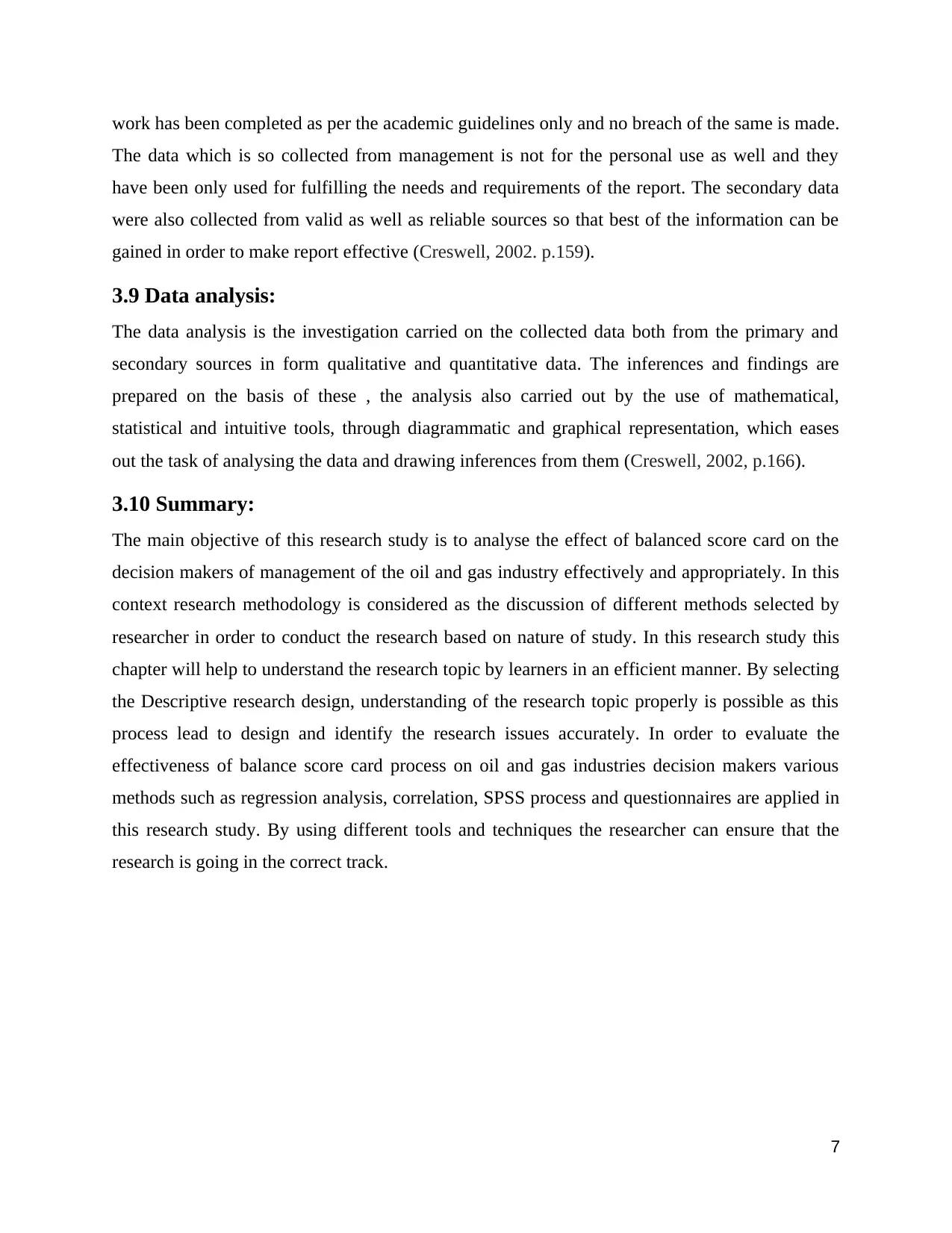
work has been completed as per the academic guidelines only and no breach of the same is made.
The data which is so collected from management is not for the personal use as well and they
have been only used for fulfilling the needs and requirements of the report. The secondary data
were also collected from valid as well as reliable sources so that best of the information can be
gained in order to make report effective (Creswell, 2002. p.159).
3.9 Data analysis:
The data analysis is the investigation carried on the collected data both from the primary and
secondary sources in form qualitative and quantitative data. The inferences and findings are
prepared on the basis of these , the analysis also carried out by the use of mathematical,
statistical and intuitive tools, through diagrammatic and graphical representation, which eases
out the task of analysing the data and drawing inferences from them (Creswell, 2002, p.166).
3.10 Summary:
The main objective of this research study is to analyse the effect of balanced score card on the
decision makers of management of the oil and gas industry effectively and appropriately. In this
context research methodology is considered as the discussion of different methods selected by
researcher in order to conduct the research based on nature of study. In this research study this
chapter will help to understand the research topic by learners in an efficient manner. By selecting
the Descriptive research design, understanding of the research topic properly is possible as this
process lead to design and identify the research issues accurately. In order to evaluate the
effectiveness of balance score card process on oil and gas industries decision makers various
methods such as regression analysis, correlation, SPSS process and questionnaires are applied in
this research study. By using different tools and techniques the researcher can ensure that the
research is going in the correct track.
7
The data which is so collected from management is not for the personal use as well and they
have been only used for fulfilling the needs and requirements of the report. The secondary data
were also collected from valid as well as reliable sources so that best of the information can be
gained in order to make report effective (Creswell, 2002. p.159).
3.9 Data analysis:
The data analysis is the investigation carried on the collected data both from the primary and
secondary sources in form qualitative and quantitative data. The inferences and findings are
prepared on the basis of these , the analysis also carried out by the use of mathematical,
statistical and intuitive tools, through diagrammatic and graphical representation, which eases
out the task of analysing the data and drawing inferences from them (Creswell, 2002, p.166).
3.10 Summary:
The main objective of this research study is to analyse the effect of balanced score card on the
decision makers of management of the oil and gas industry effectively and appropriately. In this
context research methodology is considered as the discussion of different methods selected by
researcher in order to conduct the research based on nature of study. In this research study this
chapter will help to understand the research topic by learners in an efficient manner. By selecting
the Descriptive research design, understanding of the research topic properly is possible as this
process lead to design and identify the research issues accurately. In order to evaluate the
effectiveness of balance score card process on oil and gas industries decision makers various
methods such as regression analysis, correlation, SPSS process and questionnaires are applied in
this research study. By using different tools and techniques the researcher can ensure that the
research is going in the correct track.
7
Paraphrase This Document
Need a fresh take? Get an instant paraphrase of this document with our AI Paraphraser
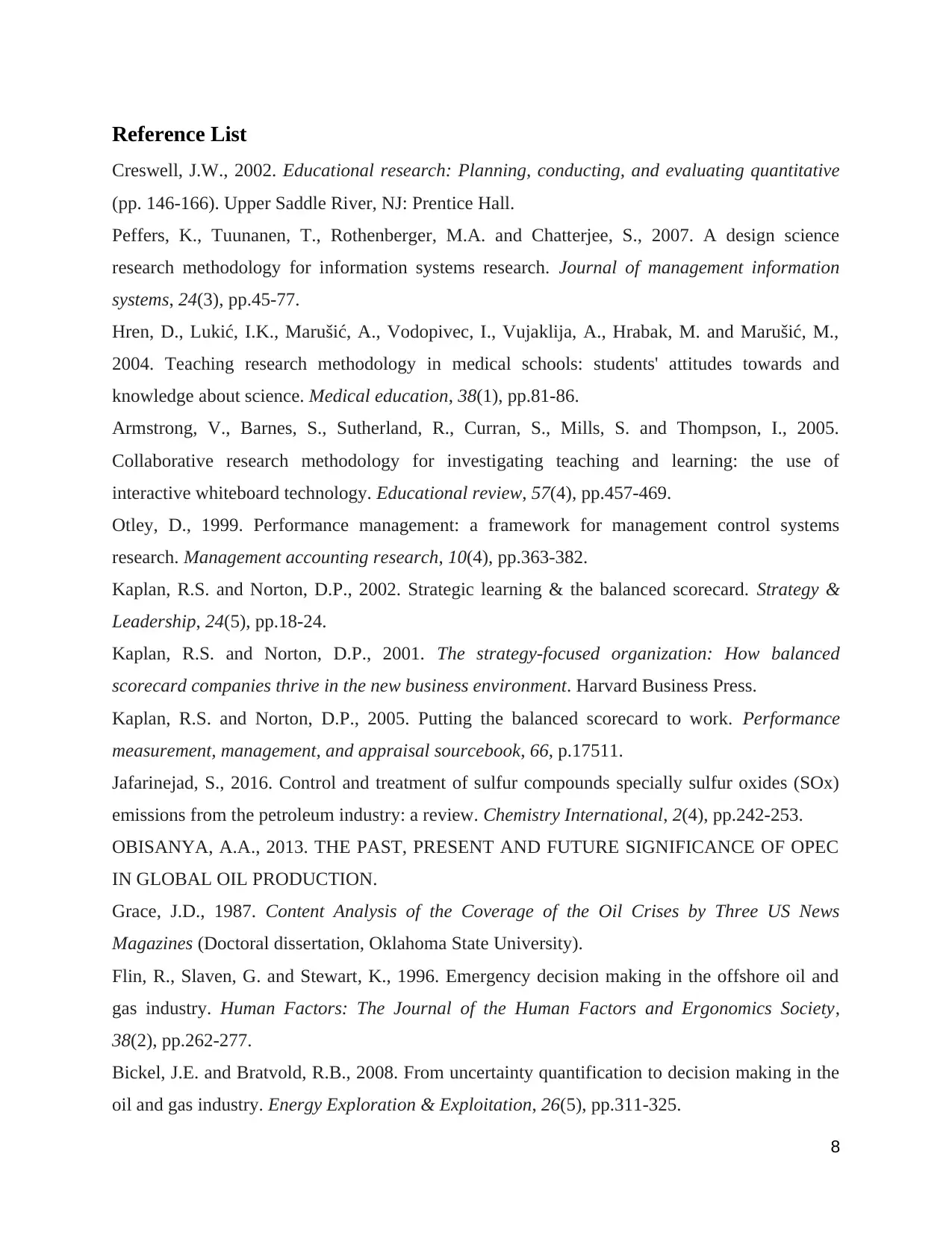
Reference List
Creswell, J.W., 2002. Educational research: Planning, conducting, and evaluating quantitative
(pp. 146-166). Upper Saddle River, NJ: Prentice Hall.
Peffers, K., Tuunanen, T., Rothenberger, M.A. and Chatterjee, S., 2007. A design science
research methodology for information systems research. Journal of management information
systems, 24(3), pp.45-77.
Hren, D., Lukić, I.K., Marušić, A., Vodopivec, I., Vujaklija, A., Hrabak, M. and Marušić, M.,
2004. Teaching research methodology in medical schools: students' attitudes towards and
knowledge about science. Medical education, 38(1), pp.81-86.
Armstrong, V., Barnes, S., Sutherland, R., Curran, S., Mills, S. and Thompson, I., 2005.
Collaborative research methodology for investigating teaching and learning: the use of
interactive whiteboard technology. Educational review, 57(4), pp.457-469.
Otley, D., 1999. Performance management: a framework for management control systems
research. Management accounting research, 10(4), pp.363-382.
Kaplan, R.S. and Norton, D.P., 2002. Strategic learning & the balanced scorecard. Strategy &
Leadership, 24(5), pp.18-24.
Kaplan, R.S. and Norton, D.P., 2001. The strategy-focused organization: How balanced
scorecard companies thrive in the new business environment. Harvard Business Press.
Kaplan, R.S. and Norton, D.P., 2005. Putting the balanced scorecard to work. Performance
measurement, management, and appraisal sourcebook, 66, p.17511.
Jafarinejad, S., 2016. Control and treatment of sulfur compounds specially sulfur oxides (SOx)
emissions from the petroleum industry: a review. Chemistry International, 2(4), pp.242-253.
OBISANYA, A.A., 2013. THE PAST, PRESENT AND FUTURE SIGNIFICANCE OF OPEC
IN GLOBAL OIL PRODUCTION.
Grace, J.D., 1987. Content Analysis of the Coverage of the Oil Crises by Three US News
Magazines (Doctoral dissertation, Oklahoma State University).
Flin, R., Slaven, G. and Stewart, K., 1996. Emergency decision making in the offshore oil and
gas industry. Human Factors: The Journal of the Human Factors and Ergonomics Society,
38(2), pp.262-277.
Bickel, J.E. and Bratvold, R.B., 2008. From uncertainty quantification to decision making in the
oil and gas industry. Energy Exploration & Exploitation, 26(5), pp.311-325.
8
Creswell, J.W., 2002. Educational research: Planning, conducting, and evaluating quantitative
(pp. 146-166). Upper Saddle River, NJ: Prentice Hall.
Peffers, K., Tuunanen, T., Rothenberger, M.A. and Chatterjee, S., 2007. A design science
research methodology for information systems research. Journal of management information
systems, 24(3), pp.45-77.
Hren, D., Lukić, I.K., Marušić, A., Vodopivec, I., Vujaklija, A., Hrabak, M. and Marušić, M.,
2004. Teaching research methodology in medical schools: students' attitudes towards and
knowledge about science. Medical education, 38(1), pp.81-86.
Armstrong, V., Barnes, S., Sutherland, R., Curran, S., Mills, S. and Thompson, I., 2005.
Collaborative research methodology for investigating teaching and learning: the use of
interactive whiteboard technology. Educational review, 57(4), pp.457-469.
Otley, D., 1999. Performance management: a framework for management control systems
research. Management accounting research, 10(4), pp.363-382.
Kaplan, R.S. and Norton, D.P., 2002. Strategic learning & the balanced scorecard. Strategy &
Leadership, 24(5), pp.18-24.
Kaplan, R.S. and Norton, D.P., 2001. The strategy-focused organization: How balanced
scorecard companies thrive in the new business environment. Harvard Business Press.
Kaplan, R.S. and Norton, D.P., 2005. Putting the balanced scorecard to work. Performance
measurement, management, and appraisal sourcebook, 66, p.17511.
Jafarinejad, S., 2016. Control and treatment of sulfur compounds specially sulfur oxides (SOx)
emissions from the petroleum industry: a review. Chemistry International, 2(4), pp.242-253.
OBISANYA, A.A., 2013. THE PAST, PRESENT AND FUTURE SIGNIFICANCE OF OPEC
IN GLOBAL OIL PRODUCTION.
Grace, J.D., 1987. Content Analysis of the Coverage of the Oil Crises by Three US News
Magazines (Doctoral dissertation, Oklahoma State University).
Flin, R., Slaven, G. and Stewart, K., 1996. Emergency decision making in the offshore oil and
gas industry. Human Factors: The Journal of the Human Factors and Ergonomics Society,
38(2), pp.262-277.
Bickel, J.E. and Bratvold, R.B., 2008. From uncertainty quantification to decision making in the
oil and gas industry. Energy Exploration & Exploitation, 26(5), pp.311-325.
8
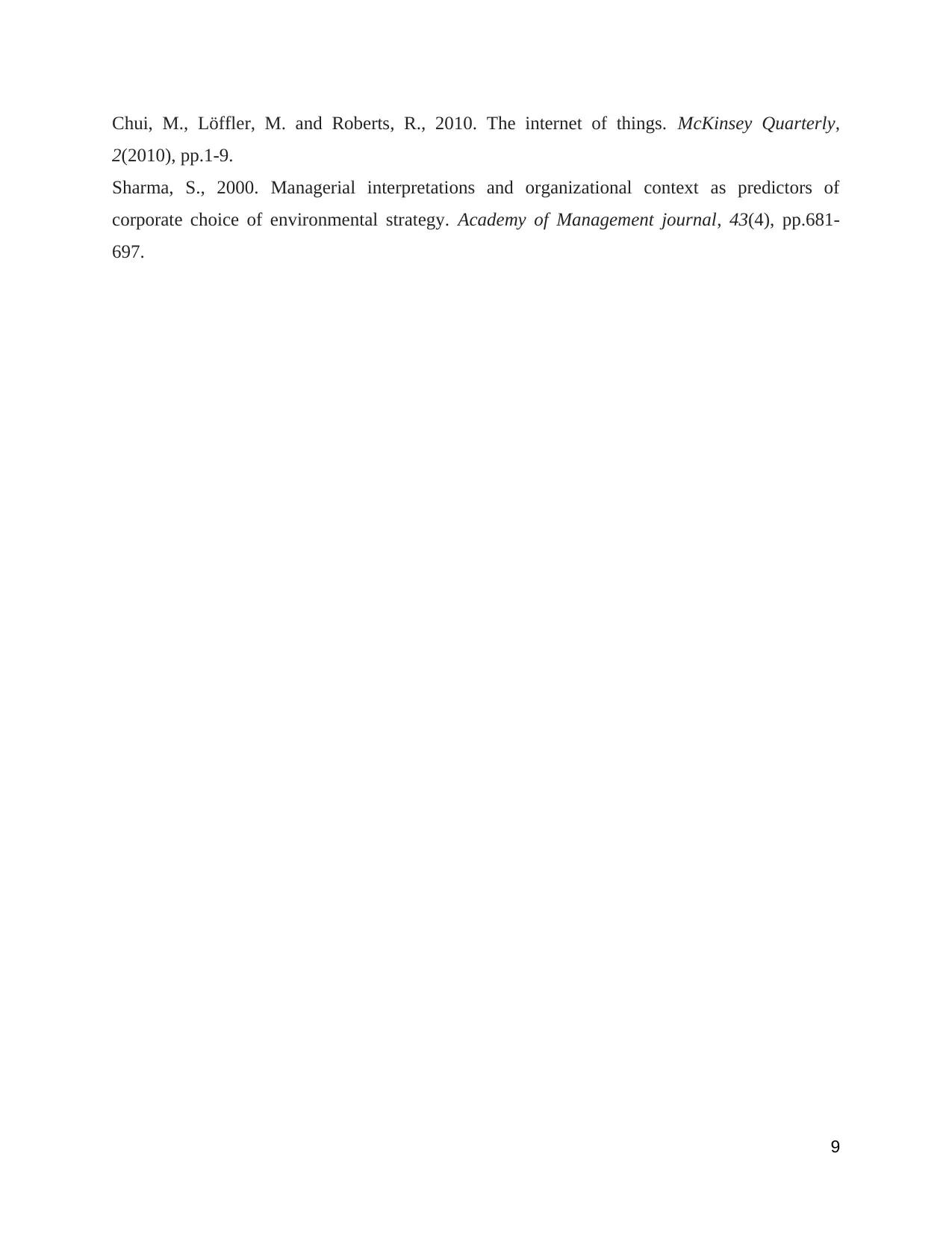
Chui, M., Löffler, M. and Roberts, R., 2010. The internet of things. McKinsey Quarterly,
2(2010), pp.1-9.
Sharma, S., 2000. Managerial interpretations and organizational context as predictors of
corporate choice of environmental strategy. Academy of Management journal, 43(4), pp.681-
697.
9
2(2010), pp.1-9.
Sharma, S., 2000. Managerial interpretations and organizational context as predictors of
corporate choice of environmental strategy. Academy of Management journal, 43(4), pp.681-
697.
9
⊘ This is a preview!⊘
Do you want full access?
Subscribe today to unlock all pages.

Trusted by 1+ million students worldwide
1 out of 9
Related Documents
Your All-in-One AI-Powered Toolkit for Academic Success.
+13062052269
info@desklib.com
Available 24*7 on WhatsApp / Email
![[object Object]](/_next/static/media/star-bottom.7253800d.svg)
Unlock your academic potential
Copyright © 2020–2025 A2Z Services. All Rights Reserved. Developed and managed by ZUCOL.





